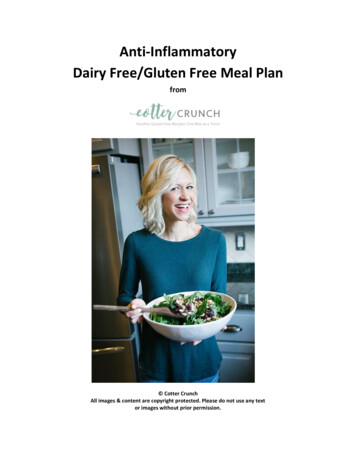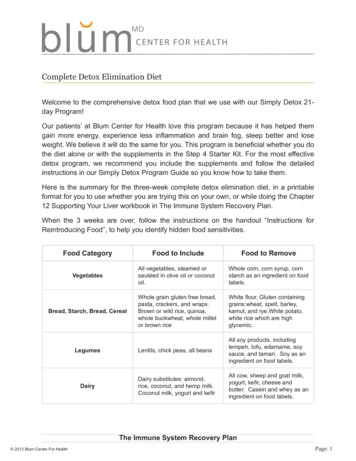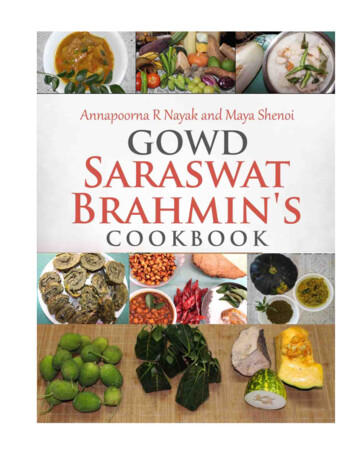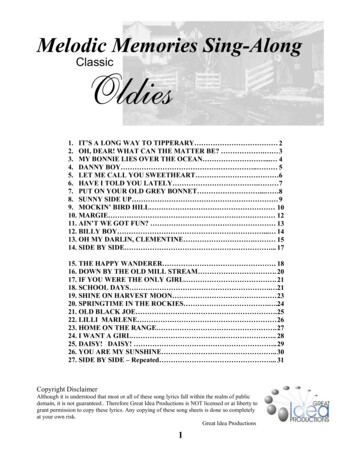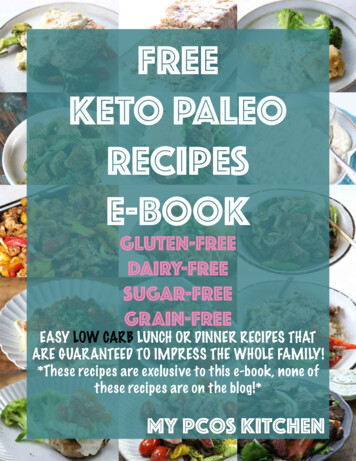
Transcription
ALL YEAR LONG.Your year-round guideto staying fit and healthyon the gluten-free diet
Be WellIt’s aGROUPTHINGFIND MOTIVATION,CAMARADERIE AND AHEALTHIER YOU IN GROUPFITNESS CLASSESBY MEREDITH QUINNNew year, new you. We hear itevery January, right around thetime we promise to be betterabout working out. But findingmotivation to go to the gymafter a long day at the office or in betweenshuttling the kids from point A to point B? It’stough. Instead of flying solo in 2016, considerjoining a group fitness class.Your resolution to eat a healthier gluten-free diet will be boosted by consistentexercise. We’re all increasingly aware thatbeing truly healthy is about more than whatwe eat.“Instead of committing to go to the gymevery day of the week, try to make it thereevery other day.”HOW TO FIND THE RIGHT CLASSWhen it comes to picking a class, prioritizeyour focus—strength and conditioning orcardio. Different classes will yield differentresults. Standards include spinning, yoga andkickboxing, but your gym will likely offer others. Don’t be put off by the cheesy names oftengiven to these classes. Read the descriptionsto see if any focus on an area of the body orworkout style that interests you.Once you’ve chosen a class, it’s about trialand error to find one you love. Before shellingout for a package of classes or a more expensive membership, ask management if you cansample a class or two.One of the biggest make-or-breaks can bethe instructor. If you don’t like his or her styleof teaching, the intensity of the workout or hisor her interaction with the class, think abouttrying out another teacher. An indication thatyou’ve found an effective teacher is whetherhe or she provides modifications to make asingle exercise challenging for each participant’s skill level. A good instructor will alsocorrect a student’s form to ensure everyone isworking out safely.THE WHAT AND THE WHYIf you’re picturing the leotards and sweatbands of the Richard Simmons era, think again.Classes at the gym have come a long way, withmany options both virtual and in-person thatmake motivation and fitness a group effort.It’s easy to make excuses for not workingout on your own, so enrolling in a class willgive you a set schedule and something to lookforward to. The group environment offers camaraderie, socializing and competition—or atleast the imagined competition you create withlady-in-the-front-with-the-pink-sneakers. Under the guidance of an instructor you’ll receivesome of the benefits of a personal trainer without paying the price for one.If you’re just starting out in a new workout routine, you don’t have to jump into itfull force. “Start small,” says Ryan Berning,a Boston-based sports performance coach.HOW TO PREPAREBefore you head out the door, grab a snack.Berning, who follows a gluten-free diet, suggests homemade gluten-free granola, Greekyogurt and a little honey. “It’s a scrumptiousand nutritious way to fuel up before a workout,” he says. And be sure to bring a bottle ofwater with you.Plan to arrive at least 10 minutes early toany class to claim your spot and set up yourequipment. Make small talk with the instructor and other participants to get a feel for theworkout ahead. Unless you’re able to make areservation, showing up late could mean there’sno room left in the class.HOW TO RECOVERAs your pulse returns to normal and yourlegs stop feeling like Jell-O, replenish thecalories you just exerted. While smoothiesare a quick and easy way to fill up, Berningsays, “Anything with a balance of proteinand carbs will do a good job of replenishing your energy stores and helping yourbody recover.”STICK WITH ITYou’ve been working hard, but you’ve yet tosee the results you’d hoped for. Fear not. “Thisis the hardest part about making the effort tobe a healthier you,” says Berning. “At the earliest, you might start to notice results in threeor four weeks, but don’t give up if it takes alittle longer.”Meredith Quinn is a contributing editor at GlutenFree Living. She can be found in the front row ofclasses including Tabata, kettlebells and the NYCBallet Workout.Not all protein powdersare created equalIf you head to the gym juice bar andwant to replenish with an extra scoop ofprotein to go along with your chia seedpower pomegranate, beware.Most protein powders have a base ofwhey, the part of milk that separatesfrom solids during the process ofmaking cheese. Whey is naturallygluten free, but often, perhaps to cutcosts or improve flavor, it is mixed withgluten-containing peptides.Ask the juice barista what kind ofprotein powder is used and if it is 100percent whey and, more important, ifit contains glutamine peptide. Someproducts that claim to be 100 percentwhey still contain this hydrolyzed wheatprotein. And even if you’re not asking foran extra scoop, make sure the powderisn’t already included in any item youorder. L-Glutamine is gluten free.Some safe bets for gluten-freeprotein powders include: Designs for Health WheyCool Garden of Life Raw Meal Jarrow Formulas Brown RiceProtein Concentrate Life’s Basics Plant Protein Mix Navitas Naturals Hemp ProteinPowder NutriBiotic Rice Protein Vanilla Rainbow Light Tera’s Wheyit comes to group fitness, you’ve heard about Zumba and CrossFit, Whenbut here are some other sessions to get you in shape during 2016.Sports performance coach RyanBerning suggests substitutinghealthy snacks such as hummus,nuts or fresh fruit in place ofyour usual go-to chips or sweetsinstead of making an extremediet change right off the bat. “Trynot to focus on the end result, justtake it one day at a time,” he says.14Gluten-Free Living Januar y/Februar y 2016ANNA FURMAN/SHUTTERSTOCK.COMPlanning to diet to ahealthier you in 2016?BARRY’S BOOTCAMPA favorite of celebrities, this hour-long workout takes place in anightclub-like atmosphere with a DJ pumping dance music. Challengeyourself with interval cardiovascular treadmill routines before strengthtraining with free weights, resistance bands and more. The workoutfocuses on a different muscle group each day, so by Friday your wholebody will feel the burn.JILLIAN MICHAELS BODYSHREDThis high-intensity endurance workout from the trainer of The BiggestLoser is taking over gyms across the country. Jillian Michaels’ 30-minutesession is organized in a 3-2-1 interval method: 3 minutes of strength, 2minutes of cardio and 1 minute of core work. The total body workoutwill get your heart pumping and your body aching—in a way that willmake you proud.DAYBREAKERDancing in the wee hours of the morning isn’t just for 20-somethingclub goers. Start your day with this pre-dawn, all-age, all-level, completely sober rave. Parties are popping up in nightclubs and yoga studios around the world with the goal of sweating it out during a 1-houryoga session followed by 2 hours of dancing to the tunes of top DJs.Grab some complimentary coffee and juice before emerging back intothe real world.ORANGE THEORYThis is an intense workout that monitors heart rate in order to stay inthe target zone and increase metabolism and energy. This routine is goodfor all fitness levels and is broken up into three components: a treadmillworkout, indoor rowing and weight training. Each time you go, expect adifferent combination of exercises to ensure you don’t get bored.HOOPNOTICAChannel your inner child and hula-hoop your way to a slimmer waistline.This California-based company specializes in “hoopdance fitness.” The fullbody workout pays close attention to the abs and core during choreographed hula-hoop routines. If you can’t make it to one of their nationwidelocations, pick up the DVD and a traveling hoop to hula at home.PELOTONIf you don’t want to leave the comfort of your house for a groupworkout, check out this virtual cycling studio. Purchase a custom spinbike and, using the touch screen near the handlebars, sign into a realtime class being live-streamed from New York City. Not only will youget an intense workout, you’ll also interact with the instructor andother participants via the screen, which tracks your progress and vitalsfrom class to class. GFwww.glutenfreeliving.com15
Be WellHOWTOSTART,FINISHANDSTAYSTRONGIN THISBOOMINGSPORTByMeredithQuinnJane C. Hoffmann follows a gluten-,dairy- and soy-free diet. She has alsocompleted two Boston marathonsand countless half marathons, but shenow favors “ultra” trail races: 30-plusmiles of twists and turns along uneven,wooded paths. Think of it as the original Tough Mudder or Spartan Race.An active member of the L StreetRunning Club, a premier group outof South Boston, Massachusetts, Hoffmann says that her preferred races are“a little more fatiguing on the body.”A little?For some, running can be torturous,grueling. For others, like Hoffmann, it’san escape, a way of being.The health benefits of running aremany: better joint health, weight loss,a boost in brain function and increasedhappiness, to name a few. Spendingeven a short amount of time joggingat any speed will improve cardiovascular health and make you feel stronger.And when you finish, there is no betterreward than the runner’s high—andbragging rights.If you are looking for ways to makeyour gluten-free life healthier, gettingout on the road or trail might be theanswer. You may have to make a fewadjustments to accommodate your dietdepending on the kind of races youPHOTO BY GIANINA LINDSEY, SNAPACIDOTICBearBrookTrailMarathon2013ON THE RUN16Gluten-Free Living May/June 2015run, but you’ll mostly bejust like everyone else trotting along the track. Andrunning can help burnthrough the calories often packed into processedgluten-free foods.MOTIVATIONAsk runners why they doit, and you’ll get a rangeof answers. Some run fortheir own enjoyment, others are training for a raceand still others crave thefeeling of pushing theirbodies to the limit.No matter the motivation, the feeling of fallinginto a comfortable pace becomes Zen-like. “I run formy head,” Hoffmann explains. “It calms me downalmost in a meditative way[and is] an amazing way toprocess things, life events,decisions, upcoming endeavors.”It’s not always that easyto jump right into running or exercise in general. Physically it may beas easy as lacing up somesneakers and putting onefoot in front of the other,but getting into the propermindset can be a challenge.And running is all aboutthe mental component—from simply getting out thedoor to halfway throughthe route when the mindsays, “No, stop, I can’t,”even though the body feelsfine. It’s important to setrealistic goals and, if youneed to, find a friend to team upwith and keep you on a schedule.Of course no one is going to getup one day and set off to run amarathon distance without having even put in a mile. Runnersshould start small. A typical 12week training program for a halfmarathon, for example, includesrunning two to three miles twicea week, cross-training two days aweek and going on a long run thatincreases in length once a week.The other two days are for rest.PASTA ANDPERFORMANCEEating right, particularly beforea long run or race, also affectsperformance, and most athletes“carb up” on pasta, bread and othercarbohydrate-heavy items. But forthose following a gluten-free diet,this pre-run tradition isn’t so easy.“I had to go heavy with potatoes and rice,” says Hoffmann, whoturns out to be a potato aficionado, eating them as snacks toppedwith peanut butter, Nutella andeven coconut oil. And she doesn’tdiscriminate when it comes to tubers—sweet, russet, yams, they’reall her friends. While in training,Hoffmann also consumes a largeamount of protein—meat, fish,powders such as Tailwind Nutrition Endurance Fuel and superstarches including those fromGeneration UCAN, both of whichare gluten free.While on a run or a long race,it’s important to stay nourishedand hydrated. As Hoffmann putsit, “Water is your big friend.”During her 50-mile, 11-hourjourneys through the woods, shebrings a bag packed with glutenfree snacks, powders and gels. Thelatter are like no-nonsense gummybears teeming with vitamins, protein and electrolytes that are help-www.glutenfreeliving.com 17
ful for replenishing the body mid-run. HoneyStinger’s gels, for instance, are honey-based,gluten-free energy chews made almost entirelyof organic ingredients.Once the run is over, it’s important to putcalories back into your body. “If you run reallylong,” Hoffmann says, “your body is strippeddown. And you’re sick of the food [you’ve broughtwith you]. It’s hard to know what your body needsmost when you’re in a state of exertion.”At most races, organizers host a finish-linereception, often filled with music, food andbeverages. It’s a nice way to unwind, catchyour breath and cheer on other runners asthey cross the finish line.Typical snacks offered include naturallygluten-free items such as bananas and nuts,but otherwise, it’s a smorgasbord of glutencontaining carbs. To avoid fainting at thefinish line, Hoffmann packs edibles that canwithstand hours in a cooler. Then she goesright for the good stuff: a hamburger. “At thatpoint,” she says, “it’s all about what you thinkyou’ve earned.”It’s not that event organizers don’t think of thegluten-free contingent. It’s merely about ratio.Gluten-free runners usually make up a smallportion of all the athletes in a race. But Hoffmannsays that once she inquires, organizers are willingto accommodate her if they can. Gluten-freeRuns with a TWISTMaking Tracks for CeliacsThis year marks the 14th anniversary of Making Tracks for Celiacs,a traditional run/walk that takesplace across the United States atdifferent times throughout theyear, though many occur in thespring.The race has raised morethan 2.5 million for the Centerfor Celiac Research and Treatmentnow at Massachusetts GeneralHospital, 75 percent of which goesto research and 25 percent tocommunity organizations acrossthe country.Race length varies accordingto location, and so far, five eventsare planned for 2015: Baltimore,Des Moines, Rochester (NewYork), Syracuse and Tri-countyMichigan. Participants set up theirown donation pages in order toraise funds from family and friendsbefore hitting the pavement andthen stick around after to enjoy aplethora of gluten-free replenishments.The Twin Cities in Minnesota, which had hosted one of thebiggest Making Tracks for Celiacsevents, are not holding one thisyear, but keep an eye out for it inyears to come. Check celiacwalk.org to find a race in your area.The Color RunThe Indian festival of Holi combined with a really fun party with a5K race thrown into the mix,TheColor Run is all about fun.The run is not timed, so participants needn’t worry about whofinishes first. In fact the slower, thebetter. After all, the whole pointof this event is that runners get18Gluten-Free Living May/June 2015covered in a rainbow of powdertossed their way at each kilometeralong the course. Participants areeven asked to wear all white sothat the vibrant colors really show.This international event istopped off with a huge FinishFestival, where runners themselvesget to throw colorful powderwhile dancing to live music. KINDHealthy Snacks is an event sponsor, good news for gluten-freeparticipants who can enjoy allthe company’s products. A nightrace is also available, during whichrunners glow in the dark as theynavigate through the course, andthis year, the run is turning the funup a notch with the glitter-filledShine Tour. Did someone say confetti cannons? Bring the kids—thisis a family-friendly event!Spartan RaceGet in touch with your innerwarrior as you complete a three-,eight- or 12-mile obstacle coursecovered in mud and water. Inaddition to running, you’ll also beclimbing and jumping, so this is notan event for the faint at heart.Every 15 minutes, more than250 racers set off in a wave, facingprimal challenges such as leapingover mud pits and sometimesinto them, carrying large bouldersand trying not to get caught up inbarbed wire.There is a kids’ version of theSpartan, so this could make for afamily day out. Aid stations linethe course, and participants areallowed to bring their own foodprovided that they have it at therunners should always ask about or suggest waysto get safe gluten-free food, she advises.With longer, warmer days upon us, runnerswill be out in full force, and race events bothbig and small will begin popping up, meaningthis is a great time to hit the road or trail tostart running.“There is a component with finishing arace that one has really trained hard for thatjust feels amazing inside and out,” Hoffmannsays. “And that feeling can linger for weeks.”Meredith Quinn is an associate editor atGluten-Free Living and is training for her secondhalf marathon.start line. Upon finishing the race,grab a banana or some PaleoRanch Jerky.Then enjoy live musicand browse professional photostaken of you along the course.Tough MudderIf you’re all about getting dirtyand working as a team, then theTough Mudder is the race for you.The top mantra of this obstaclecourse is teamwork—in fact eachparticipant takes an oath beforethe starting whistle, promising to“put camaraderie before coursetime” and to “help fellow mudderscomplete the course.”This supportive environmentemulates the spirit of the charityit benefits, the Wounded WarriorProject.With 10,000 to 15,000participants in every event, youwould think it’s tough to getlost in the crowd, but just theopposite is true. From jumpinginto a giant mud pit to scaling ahalfpipe, navigating monkey barson a human hamster wheel torunning through 1,000 electrifieddangling wires, team members andrandom participants alike encourage and coach each other alongthe entire 10 to 12 miles. Kids canget in on the fun as well with theone-mile Mini Mudder sponsoredby Fruit Shoot, a line of all-naturalkids’ fruit drinks.Though outsidefood and drinks are not allowed,exceptions are made for thosewith dietary restrictions. Selectaid stations along the course willprovide bananas.Wicked Wine RunThere are many food-themed runsout there, but as you can probablyimagine, most of them featurefoods that are not gluten free,such as Twinkies, hot dogs andcorn dogs.However one run may getyour feet moving. The WickedWine Run is for folks 21 orolder, with event locations mainlyin Texas and California. Additionaldates are quickly being added inMissouri, Louisiana, New Mexico,Oregon and Washington.There are three options forracing: a 5K with wine at the end,a 1K tasting walk with four winestations along the way, or a combination of the two. This is a fun,costume-wearing crowd enjoyingmore of a party atmosphere thana competitive event. If you don’tsee a race near you, write in toget the grapes rolling. As wine isnaturally gluten free, you shouldbe safe here. At the end of therace, enjoy a bash featuring morewine, live bands and, in mostcases, food trucks that sometimes offer gluten-free options.Superhero ScrambleIf you were one of those kids whodreamed of being a superhero,then don your cape and grabyour sidekick for the SuperheroScramble. Be surrounded by yourfellow protectors of the universewhile you jump, soar and fightyour way along four, eight or 13miles filled with obstacles such asscaling walls, jumping over fire andsliding down a chute of slime. Afterthe race, which is held both duringthe day and at night, stick aroundfor the after party, which featureslive entertainment and music, plusrefreshments.WHAT’SIN THATPOWDER?If you want todo The ColorRun but arewary of whatexactly is inthe tie-dyedcloud floating its waytoward yourface andmouth, fearnot. Thenon-toxiccolor is madefrom a glutenfree Melojelcornstarchbase that istinted withfood-gradedyes.TRADITIONAL RACES5KThe shortest of the traditional racedistances, a 5K equates to 3.1 miles.This type of race stands on its ownor can be incorporated into a largermarathon event. It’s also a populardistance for charity fundraisers asit can be completed by those whowould prefer to walk or do a run/walk combination. Beginning runnersoften use the 5K to get a taste ofcompetition, and in many instances,children are also allowed to participate.10KMid-level runners will be comfortable running a 10K, which is 6.2miles. It’s a nice stepping stone in therace world, but, unfortunately, formal10Ks are a little harder to comeby. Perhaps they’re simply beingoverlooked by organizers who figurethat beginning runners do a 5K andeveryone else is likely on board forat least a half marathon. That said,those runners gearing up for a longer race sometimes coordinate theirsix-mile training run to coincide witha 10K event.Half marathonThose testing the racing watersto figure out if they have what ittakes to do a full marathon typically start out running a half. Its 13.1miles makes for a nice distance thatcertainly pushes mental and physicallimits but is still manageable enoughto train for. While preparing, runnersThe Color Run 5K raceshould absolutely get up to 11 miles;the rest can be gutted out. This isalso a distance where hydration andnourishment really play a role, soplan ahead according to how yourbody behaves during training.MarathonYou’ve seen them on television orin person in major cities around theglobe. You’ve passed cars with the26.2 bumper stickers. Marathons arethe kings of the running world, thegrandest being the Big Six: Boston,Berlin, Chicago, London, New YorkCity and Tokyo. In training, runnersget up to at least 20 miles for a longrun and typically log about 40 hoursof running per week for about sixmonths. An important part of theprocess comes toward the end oftraining, which calls for a taperingdown of the weekly mileage in orderto decrease the amount of stress tothe body.UltraFor those who just can’t get enoughof racing and running, ultra races areany distance greater than a marathon. Standard distances are 50K(32.2 miles), 75K (46.6 miles), 50miles and 100 miles—“for the realcrazies,” Hoffmann says with a laugh.Obviously these are races that taketraining to an entirely different leveland often include following behindanother runner whose sole job is tokeep a steady, manageable pace.HydrationstationAlong any race course,you will find aid stationswith water or sportsdrinks like Gatorade.You should research howmany stations will bealong your course. Mostdrinks are gluten free, soyou are likely to be safe,but you should checkahead of time to makesure there’s nothing thatcontains gluten. “It’s nofun to do a race and haveto skip aid stations,” runner Jane Hoffmann notes.Here is how you cantake advantage of an aidstation without hurtingyour race time:Yes, stop at an aidstation if you need it.Skipping one to save afew seconds will hurt youin the end if you have towalk due to fatigue.When you approachan aid station, grab a cup,move out of the otherrunners’ way, come to astop, take a big sip andthen slowly trot off, finishing your cup.Trying torun and sip a full cup willjust end up in a mess andcreates a possible choking hazard.If you are overheated,grab a second cup andpour it over your head.When finished, tossyour cup to the ground.The volunteers manningthe aid station will takecare of cleanup.www.glutenfreeliving.com 19
Be WellBy Meredith QuinnTAKE SWIMMING FROMA SUNNY DAY ACTIVITYTO A SERIOUS WAY TOSTAY IN SHAPEMAKINGWAVESFhADAM PRETTYDANIEL OCHOA DE OLZAP16Gluten-Free Living July/August 2015www.glutenfreeliving.com 17
THE RIGHT STUFFSwimmers burn a lot of calories in mere minutes, soit’s important that they nourish their bodies before,during and after a meet.Wurster prepares protein pancakes that are madewith almond butter, almond flour, egg, chia andbanana. “It has a good mix of protein and carbohydrates,” she says. (See recipe page 56.)Though Vollmer tries to eat a small nutrientdense breakfast beforehand, she says that the mostimportant meals are those in the days before the bigcompetition. “Carbing up is a thing of the past,” thefour-time Olympic gold medalist says. Instead shemaintains her normal diet. “Changing a diet shocksthe body and can hinder performance,” Vollmerexplains. “I have always felt that on race day, mybody is fueled by what I ate the previous two days.If I [only] eat healthy the day of the race, I don’thave the stores needed to have a good performance.”After the preliminary rounds of a meet, Vollmermakes time to have a large lunch to get her throughthe final stretch. Meanwhile she keeps a variety ofgluten-free snacks nearby, such as trail mix, fruit,fruit bars, crackers, a recovery protein bar and arecovery drink.To keep her body fueled, Wurster developed arecipe for cookie dough-like treats that she and herteammates call Yum-Yums—they snack on them inbetween heats.Both Wurster and Vollmer finish race day witha well-rounded meal. Wurster rewards herself withsomething she really likes, typically a gluten-freepizza made with almond flour. “Then I combinethat with something really healthy and packed withvitamins—usually a green juice from a local juicebar or kale salad or steamed broccoli,” she says.GETTING SERIOUSWhile you may not think you’re ready to take your doggie paddle tocompetition-level butterfly, Vollmer says that it’s never too late to getonto the starting blocks. “That’s one of the amazing aspects of swimming—it’s a form of exercise you can do at any age,” she explains.Wurster notes that making the transition from recreational swimmingto a competitive environment can be easy. “Practice is very similar tocompetition,” the 11-year old says. “It is not like football or basketball,where the competition can change every time. In swimming the wateris always the same and the pool is always the same length. So if youcan swim laps, you can be in a competition.”As far as the weather goes, Vollmer says that, rain or shine, she’s swim-Mia’s YumYumsThis is a race day favorite that MiaWurster likes to whip up for extraenergy. Once you make these a few times,you will be able to estimate the proportions of ingredients and can make themmuch faster.MAKES ABOUT 22 BALLSIngredients 1¼ cups gluten-free oat flour¾ cup almond butter½ cup coconut oil½ cup gluten-free rolled oatsDirectionsCombine all ingredients in a bowl and mixtogether. Roll the mixture into small bitesize balls and freeze overnight.Nutrition Analysis (per ball): 160cal, 12 g fat, 0 mg chol, 25 mg sodium, 12g carbs, 2 g fiber, 6 g sugar, 3 g protein.18Gluten-Free Living July/August 2015UNITED STATES OLYMPIC COMMITTEE¼ cup maple syrup, Grade B 1 tablespoon chia seeds 1 tablespoon flaxseeds ½ cup dark chocolate chipsDON’T HOLD BACKLiving gluten free hasn’t stopped Wurster andVollmer from gliding through the water at recordbreaking speeds. And Wurster has plenty of advicefor kids on the diet. She says being gluten free canhelp rather than hurt an athlete’s performance. “Ifeel stronger and lighter since being gluten free, andI think that helps in any sport,” she says.Wurster looks up to Vollmer as an inspirationboth inside of the pool and out. “I know that after she missed the 2008 Olympics, she had to giveup gluten and then she set all kinds of records atthe 2012 Olympics,” Wurster says. “So she is livingproof that you can be a champion as a gluten-freeathlete.” GFMeredith Quinn is an associate editor at Gluten-FreeLiving and will be working on her butterfly in NewHampshire this summer.ReadDanaVollmer’sblogStroke by strokeSqueeze into your suit, strap on some goggles, and get readyto go from beach bum to swimming sensation this summer.Here are some basic moves to get you started.STROKEHOW IT’S DONECaloriesburnedin 10minutesBreaststrokeHead stays above water while below the surface, arms and legs simultaneously sweep forward, out to the sides, and then back in towardthe chest. Most advanced swimmers submergetheir heads to be more efficient.60BackstrokeSwum on the back with legs kicking up anddown while arms alternate large, backwardcircular motions that sweep from above tobelow the water.80FreestyleThe fastest and most efficient stroke. Swum onthe stomach with flutter kicks and alternatingforward arm motions reaching in front of theswimmer and then pulling back in the water.The face should be submerged, rotating outfrom underwater simultaneously as one armpulls back in order to catch a breath.100ButterflyRequiring a lot of strength and great coordination, this stroke involves synchronized freestylearm movements paired with a double-footeddolphin kick.150www.glutenfreeliving.com 19UNITED STATES OLYMPIC COMMITTEEwhich means warm weather,spending time at the beach and splashing in your favorite body of water.Whether you’re in a backyard pool, along a sunny coastal shore or at atranquil lake in the mountains, incorporating swimming into your fitness routine can help you exercise without harsh impact on your joints.Swimming also works out stiff muscles, strengthens your heart, increases blood flow and improves flexibility and range of motion. Plusthe rhythm of the water paired with your steady breathing are saidto create yoga-like meditation, releasing endorphins that will improveyour overall happiness.“Swimming is a full-body workout,” says Olympic gold medalist DanaVollmer, who found out well into her professional swimming career thatshe has gluten sensitivity and an egg allergy. “While a workout can havea leg or arm focus, you have to use your entire body through the [swimming] process.”And by doing so, those on a gluten-free diet are able to quickly burnthe extra calories often found in pre-made meals and snacks. In fact just10 minutes of swimming can burn 60 to 150 calories, depending on theintensity of the stroke. This can also help you maintain a healthy weightISTOCK/MASARUHORIESUMMERIS HERE,ming—unless there’s lightning. “I totally understandhow if it’s pouring rain, getting in a swimsuit andheading outside to jump in the pool could be thelast thing you want to do,” she says. “However I[remind] myself that most outdoor pools are keptat a warmer temperature. Once you’re in, the raindoesn’t matter—it’s the lifeguards I feel sorry for.”while decreasing the risk of diabetes and heart disease.Vollmer credits the lack of gluten in her diet for improving her swimm
This high-intensity endurance workout from the trainer of The Biggest Loser is taking over gyms across the country. Jillian Michaels’ 30-minute session is organized in a 3-2-1 interval method: 3 minutes of strength, 2 minutes of cardio and 1 min


